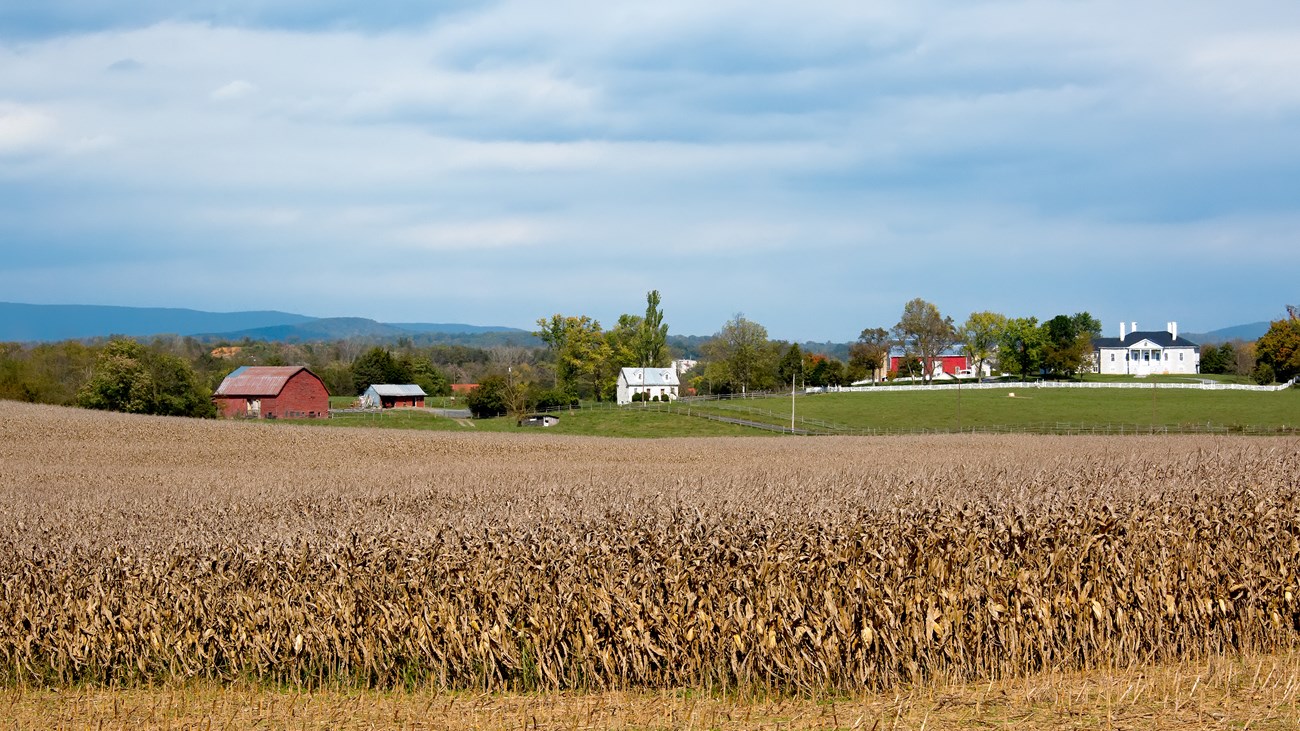Last updated: July 26, 2022
Article
Age of Grain

Ann & Rob Simpson
“… propitiously located for commercial wheat farming and the conversion of wheat to flour. The fertile limestone-based soils of the river bottom lands were supremely well suited for the production of wheat.”
The period 1730 to 1900 was Virginia’s “Age of Grain.” Economics, transportation, and industry made the Shenandoah Valley the most productive wheat producing area in the South. Belle Grove sat the height of an agricultural economy based on grain and slavery.
Native American Farmers
Around 1000 years ago, Native American cultures began growing crops near the Shenandoah Valley. Their villages and crops were located along riverbanks, presumably to take advantage of the most fertile soil. Early crops were mostly local plants: squashes, walnuts, sunflowers and a kind of quinoa, which all grow well in a region fertilized by limestone. During the Little Ice Age, a period of global cooling, other cultures moved into the Valley, perhaps driven south by colder temperatures and poor crop harvests. These people began to grow corn (maize) and beans.
Colonial & Early American Farmers
The early colonists of the Shenandoah Valley practiced a highly diversified form of agriculture compared to other areas of the South that focused on single cash crops, such as tobacco or cotton. Valley farmers raised a wide variety of crops and farm animals for home use, as well as for local sale or barter: corn, cereal grains, grasses for livestock, and flax for linen. Horses provided power and transportation; cattle provided meat, milk, cheese and butter; swine was a main staple for protein; and sheep provided both wool and meat. Initially, tobacco and hemp were grown as cash crops, but their retail value declined dramatically after the American Revolution.
Rise of Wheat
Valley farmers soon learned that wheat could easily be grown in the fields rich with limestone deposits. The French and Indian War stimulated increased demand for flour in order to feed the soldiers and this demand was large enough to mitigate the cost of transportation to big city markets, such as those in Baltimore and Philadelphia. By 1810, the Valley was considered the leading wheat producing region in the entire South.
Mills
Thanks to the steep terrain and swiftly flowing creeks, such as Cedar Creek and Opequon Creek, flour mills, powered by water, were abundant in the region. Local mills in the Middletown area included: Hottle Mill (part of the Hite complex); Stickley Mill (remains still standing); Bowman's Mill (where Kershaw's troops crossed Cedar Creek); and Miller’s Mill (where General Ramseur was mortally wounded). Although, grinding flour and meal was their main purpose, the mechanical energy of the mills was used to saw logs, grind plaster, process wool, press apples, and prepare fertilizer.
Trade & Transportation
The trade connections with urban markets enabled Valley businessmen to import manufactured goods into the region for resale; at the same time, wheat sales increased the level of disposable income for the rural middle class. Construction of the all-weather Valley Turnpike, followed by railroad connections at Strasburg and Winchester, facilitated easier transportation to urban markets.
Breadbasket of the Confederacy
During the Civil War, the Shenandoah Valley held great strategic importance; the Valley provided Confederate Armies access to Maryland, Pennsylvania and the District of Columbia, while the Turnpike enabled quick movement of troops and artillery. The high levels of agricultural production led Confederate leaders to refer to the region as “The Breadbasket of the Confederacy.” By 1864, Federal forces has been ordered to destroy the Valley as a source of food and supplies. In a period known as “The Burning,” Federal troops systematically destroyed thousands of barns, killed or confiscated livestock, and burned the mills. However, Valley wheat production continued to expand despite the war and the destruction.
Post-War
After the war, Valley farmers continued to produce record amounts of wheat, especially compared to the rest of Virginia. For example, in 1900, the Valley produced 40 percent of Virginia’s wheat but utilized only 13 percent of the farmland. Recovery was encouraged by the Baltimore Agricultural Aid Society, which provided farmers with livestock, seed and farming implements; economic recovery of the Valley strongly benefited the merchants of Baltimore. Additionally, farmers invested in mechanical devices, such as reapers and threshers.
Change
By the end of the 1800s, Valley farmers began to shift their efforts towards apple orchards and the dairy industry (milk, butter and grasses fed to cows). Wheat production reached an all-time high in 1920, because of demand created by World War I, but steadily declined throughout the 1940s. Modern farmers also produce a significant amount of poultry, including chickens, eggs and turkeys.
